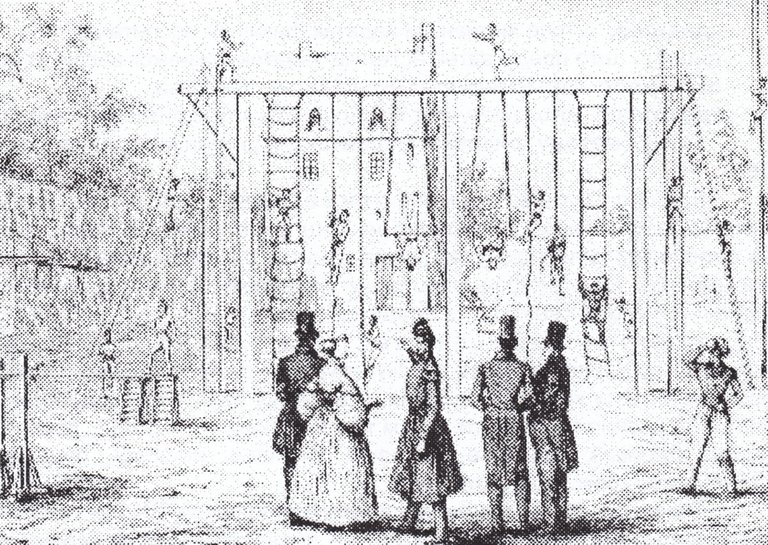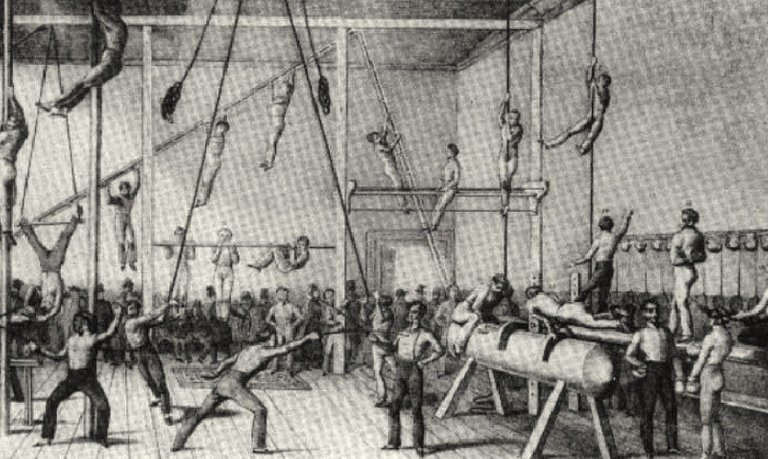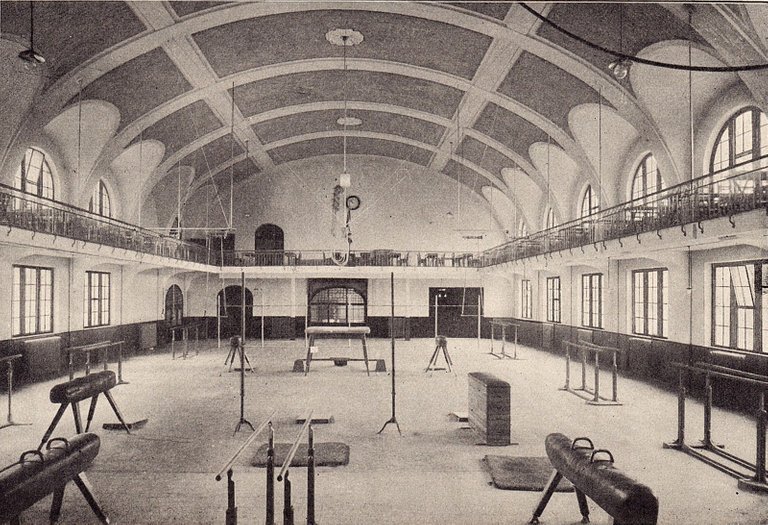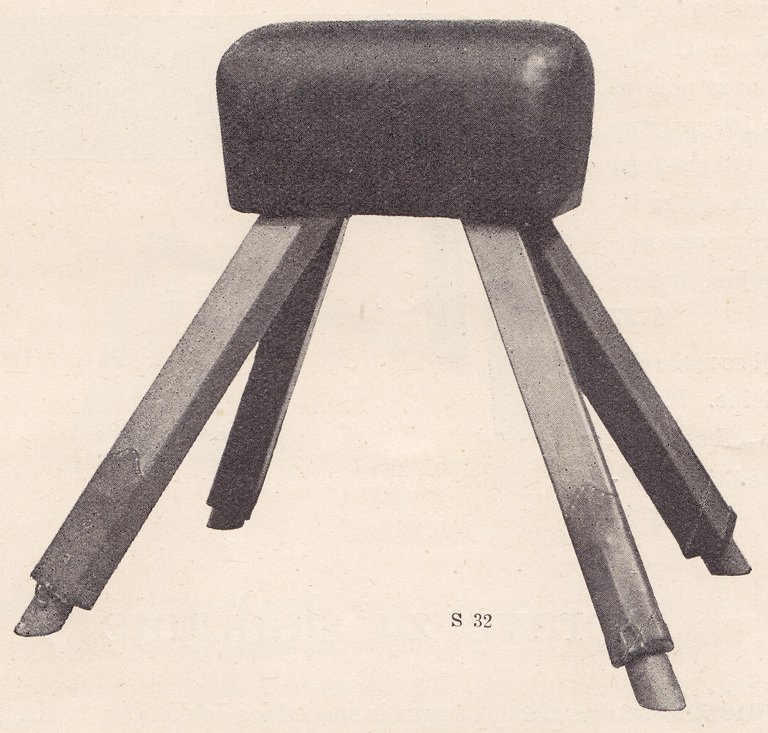[Текст на српском] From the mid-19th century gymnastics, beside other activities which were introduced somewhat earlier by private initiative in the Principality of Serbia - such as equestrian activities, fencing, martial arts, swimming, was recognised as the first by its importance and unavoidable body exercising activity which needed to be given an appropriate place in the educational and the social life of Serbia. The thought of the progressive and the esteemed individuals of that period, and the government officials, on the usefulness and necessity of the introduction of gymnastics into the state institutions, was slowly gaining ground.

Amoros High School Gym
While in the first half and during the middle of the 19th century famous gymnastic systems had already been developed in Europe – in Germany Jan’s tournament gymnastics, in Sweden Ling’s gymnastics, in France Amoro’s exercising system (Ling’s gymnastics on modified tournament equipment), and in Bohemia (modern day Czech Republic) and Slavic countries where German tournament gymnastics was transformed into Sokol exercising system – in the Principality of Serbia only some exercises which could be seen and learned in the Western countries had been introduced. At Belgrade Higher School, (1808) Fencing was introduced as a subject, which was taught “according to a modern method” by a captain of Belgrade riders Petar Djuraković. Private schools were also founded: fencing schools – Nikolić’s in the town of Kragujevac (1839), Ninić’s (1843), Koder’s (1848), Wilmes’s (1851) in Belgrade; Lepojević and Danić’s swimming school in Belgrade (1843); since 1850 fencing, swimming and gymnastics were taught to the cadets of the Belgrade Artillery School, and particularly prominent was Sedlmayer’s gymnastics school in Belgrade (1866). Exercising in these private schools – “the institutes” which were opened in the Principality of Serbia, was the result of initiatives of persistent social-sport missionaries arguing for the organised physical exercising and propagation of healthy way of life among the populace and the youth.

Ling's gym
Gradually, gymnastics was introduced in state schools, first in the military schools. Some twenty years before Belgrade youth would gather in the gymnastic Company of StevaTodorović, the curriculum of Požarevac Military School included gymnastics (1838). Gymnastics was taught to the cadets of the Belgrade Artillery School from its very founding (1850). Gymnastics, martial arts and swimming were taught by officers on active duty, such as Dimitrije Karadžić (the son of Serbian linguist Vuk Karadžić), but also by famous masters of these skills such as Jovan Zamastil, Đorđe Marković Koder, Ferdo Mihoković, Atanasije Popović, and later by the Czech Sokol leader and the Headmaster of the Artillery School Miroslav Vojinović (from 1908, until 1927, before changing it, his name was František Hofman).

Gymnastics Hall of German Turners, Berlin, 1913.
Bodyexercising of “neck-breaking, difficult and dangerous” gymnastics, which was to be accepted as the basic means in children education and whose place in the curriculum needed to be struggled for, was propagated by distinguished individuals of Serbia from the scientific, political, artistic and literary communities, including Jovan Jovanović Zmaj, Laza Kostić, Laza Lazarević, Vasa Pelagić, Živojin Žujović, Svetozar Marković, Josif Pančić… That was a time of conservative understanding and slow acceptance of school gymnastics, occasional bans, objections, and even obstructions, by both teachers and parents. The process of introducing gymnastics into schools was not going easily at all. There were either not enough trained teachers, or they could not manage their classes; there were not enough gyms, equipment was lacking and this would be felt until the end of the century.

Jumping Apparatus (Goat)
The Ministry of Education made efforts to overcome these problems by passing legislation, introducing obligatory exercising programmes, sending letters and working instructions to schools. Through the “Law on the Organisation of High Schools” (1863) the Minister of Education and Religious Affairs had decreed that the gifted students, beside church singing and music, could have gymnastics a subject as well. Since then (1863) the famous German gymnastics teacher Ascanius Sedlmayer had taught German tournament gymnastics to the students of Belgrade elementary and middle schools according to the tournament system. But, gymnastics would become a subject officially only in 1882. Gymnastics was introduced into the curriculums of elementary schools in the Principality of Serbia at the end of 1868 (by the Writ of the Minister of Education from 10 December), which would over time influence the popularisation of exercising among the population. In the Writ the Minister recommends that “the teachers of elementary schools devote three to four hours every week for gymnastics after school, which the children can exercise at school or in the field outside the school building when the weather is fair”. The commissions, which adopted the instructions, recommended that gymnastics should be an obligatory subject in town and village schools, with two classes per week in middle schools (1869).
Officers and non-commissioned officers, who taught military skills, were among the first gymnastics teachers in schools. That was how the issue of insufficient number of gymnastics teachers was being solved in state schools, but also later in the civilian gymnastic associations. Instruction was conducted as a pre-military service training, and this trait of the exercises was ascribed to the political and military ambitions of Prince Mihailo and King Milan Obrenović, who wanted the Serbian army to be trained according to modern standards, and the reserves recruited from amongst the middle school students to be more ready. From the school year 1882/3 officers and non-commissioned officers taught gymnastics at the Faculty of Orthodox Theology, teacher schools in Belgrade and Niš, lower and regular high schools throughout Serbia.
Because there were not enough teachers, “Military Science and Gymnastics” were merged into one subject (in 1853, under the “Organisation of High Schools and the Lyceum” law), even though there were some other initiatives: in 1869; in 1873, the Initiative for the Merger in Higher and Middle Schools; in 1881, under the “Law on High Schools Organisation”. Thus in 1882 Gymnastics and Military Exercising Curriculum was adopted and printed in a 1000 copies. Over time, due to pronounced military character of these exercises, discontent grew and so it was recommended that the military should be separated from the physical exercising and that for a time officers should not be teaching (1890), and this led to the situation that in many schools in Serbia there were no gymnastics classes throughout the entire last decade of the 19th century. Authoritative, responsible and meticulous officers-teachers were also men such as the famous Serbian field-marshals, generals who served as Defence Ministers, among them then young sub-lieutenants Živojin Mišić in the First Belgrade Lower High School and Stepa Stepanović in Kragujevac High School.
— Oko Sokolovo (Hawkeye. In Serbian), 57—58, 2015.
Duke Stepa Stepanović (1856 Kumodraž – 1929 Čačak) – As an infantry lieutenant he was appointed to be a teacher of physical and military exercises of Grammar School in Kragujevac on August 28, 1882. Soon, prevented by other duties, he was released on September 3, 1882. The next year he was restored to the position of a physical and military exercises teacher in the same school (March 9,1883), where he stayed until August 16, 1884. As a good lecturer, he held classes of physical and military exercises to senior year students. According to some sources, Stepa was described as a disciplined and an authoritative educator, responsible and pedantic in teaching duties, and very correct towards both the teaching staff and students.
— Oko Sokolovo, 59–60, 2016.
References: Jovanović, B. (1957). *Поводом стогодишњице организованог физичког васпитања у Србији*. [On the occasion of hundred years of the organised physical education in Serbia. In Serbian]. Physical culture 7–8. 326–332; Vukašinović, V. (2016). *Гимнастика и соколство у Србији до 1941. године, великани српске гимнастике и соколства*. [Gymnastics and Sokol in Serbia until 1941, great names of Serbian gymnastics and Sokol, monographic publication. In Serbian]. Belgrade: University of Belgrade; Vukašinović, V. et al. (2017). *Са гимнастиком је почело… телоупражненија, теловеџбање, гимнастисање, соколска теловежба…*. [It started with gymnastics… physical exercises, gymnastics, Sokol physical exercises … In Serbian]. Physical education and sport through centuries, 2 (4) 2017, 40-53; Petrović, V. Ј. (1983). *Физичка култура до 1941. год.* [Physical culture until 1941. In Serbian]. In М. Maletić (ed.), Sociajalistička republika Srbija, II tom (pp. 429–454). Belgrade: Književne novine; Trujić, N. (1976). *Физичка култура у школама Србије у 19. веку*. [Physical Culture in schools in Serbia in the 19th century. In Serbian]. Belgrade: Komisija za istoriju, arhiv i muzej fizičke kulture Srbije.
Old photographs of unknown authors: Karl Stelz, (Amtsbaumeister), Schulturnhallen, Vereinshäuser und Barackenbauten (für Schulturnen, Vereinszwecke und sonstige Betätigungen im Sinne der Jugendpflege), Verlag von Otto Baumgärtel W30, 1913; from the collection of Vladan Vukasinovic. Photo editing: @lighteye.